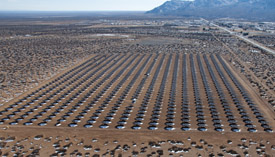Army’s largest solar PV array is world’s largest low-concentration PV project
 The U.S. Army recently dedicated its largest photovoltaic system at White Sands Missile Range, in New Mexico recently. At over 4 kilowatts, the system includes solar carports and what, at 4.1 megawatts, is the world’s largest low-concentration PV array. It’s just the latest move for the military as the U.S.’s armed forces transition to a renewably powered energy strategy.
The U.S. Army recently dedicated its largest photovoltaic system at White Sands Missile Range, in New Mexico recently. At over 4 kilowatts, the system includes solar carports and what, at 4.1 megawatts, is the world’s largest low-concentration PV array. It’s just the latest move for the military as the U.S.’s armed forces transition to a renewably powered energy strategy.
During a ceremony to commission the installation White Sands Commander Brig. Gen. Gwen Bingham said, “I came here about four months ago talking about how White Sands is a national treasure and now we can feel proud that we're really on the environmental edge," Bingham said. "It takes passion to do something like this. I'm just excited about the journey that will lie ahead."
In all, the system will provide about 10 percent of the facility’s energy needs, according to the Army, providing it an estimated annual savings of $930,000. The installation includes the world’s largest low-concentration PV array, a 4.1 megawatt installation on a ground-mounted tracker system.
"A sunny location like New Mexico provides an ideal site for solar power,” said Garrison Commander Col. Leo Pullar. “This project illustrates the U.S. Army's commitment to going green, our focus on operating on net zero energy, and doing what we can to help protect the environment," he said.
The low-concentration PV system uses Solaria’s unique concentration system. “This solar-energy system demonstrates that the U.S. government's goals for enhancing security through energy independence can be met both economically and practically when the public and private sectors work together," said Solaria CEO Dan Shugar.
While much emphasis of late has been on the high-concentration PV systems, where a lens focusses sunlight on multi-junction PV cells at levels that magnify the sun’s rays by hundreds or even more than a thousand times, low-concentration PV cells use more conventional silicon-PV cells and concentrate the sun that hits them by a few times up to about 10 times. For instance, Solaria cuts standard silicon PV cells into tiny strips, which are packaged and then attached to optics that magnify the production capacity of the PV cells.



